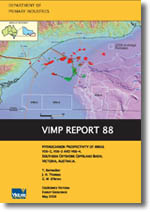VIMP Report 88 - Hydrocarbon Prospectivity of Areas V06-2, V06-3 and V06-4, Southern Offshore Gippsland Basin
 |
| |||||
Product description:Executive SummaryThe Gippsland Basin is situated in southeastern Australia, located about 200 km east of the city of Melbourne, and is well serviced by roads and population centres. About two thirds of the basin lies offshore representing one of Australia's most prolific hydrocarbon provinces. Most of the discoveries to date have been hosted within the Late Cretaceous to Early Tertiary Latrobe Group with Initial Proven Reserves estimated at 4.3 billion barrels of oil (Bbbl) and 13.5 trillion cubic feet (Tcf) of gas. The remaining 2P reserves have been assessed at 400 MMbbl of liquids and 7 Tcf of gas. Around 80,000 line km of 2D seismic data and thirty 3D seismic surveys have been acquired, and over 300 exploration wells have been drilled in the basinís 46,000 km≤. Thus, although a mature basin by comparison with other Australian basins, by world standards, the Gippsland Basin is still relatively under-explored. A network of pipelines transports produced hydrocarbons to the onshore petroleum processing facilities at Longford and Orbost. From here, pipelines deliver Gippsland gas to Sydney in New South Wales, to Adelaide in South Australia and to Tasmania. The potential for additional discoveries is expected to ensure continued interest in the region, which will also be maintained by an increasing market demand for natural gas in the southeastern Australian region. The areas described in this report were partially explored by previous operators who identified several prospects and leads. All areas offer significant opportunities for hydrocarbon entrapment in several different play types. The Southern Platform areas (V06-2 and V06-3), have hitherto been deemed unprospective, because exploration in the late 1960s had not met with success. All five wells drilled on the platform targeted a pinch-out play, involving rapidly thinning Latrobe Group sediments over Palaeozoic basement capped by the regional seal of the Seaspray Group. All wells were dry and, although Groper-2 did have some indications of a petroliferous odour in cores, the play was no longer pursued. Since that time, however, oil and gas has been discovered along the southern margin of the basinís Central Deep providing encouragement for a new appraisal of the platformís prospectivity. A re-evaluation of seismic, aeromagnetic, well-log, drill-core and geochemical data has identified distinct variations to the basic pinch-out play. All three plays listed below depend on communication with source rocks within the Central Deep or on in-situ biogenic gas generation.
All three blocks require additional work in order to define the trapping mechanisms and timing as well as the maturation and migration setting. All three blocks have demonstrable play fairways and are adjacent to a proven petroleum system. This in itself should ensure that the blocks provide exciting and challenging opportunities for potential explorers. Bibliographic reference Bernecker, T., Thomas, J.H. & O'Brien, G.W., 2006. Hydrocarbon Prospectivity of Areas V06-2, V06-3 and V06-4, Southern Offshore Gippsland Basin, Victoria, Australia. Victorian Initiative for Minerals and Petroleum Report 88, Department of Primary Industries. Download 34467 VIMP88 Report (PDF) | ||||||

